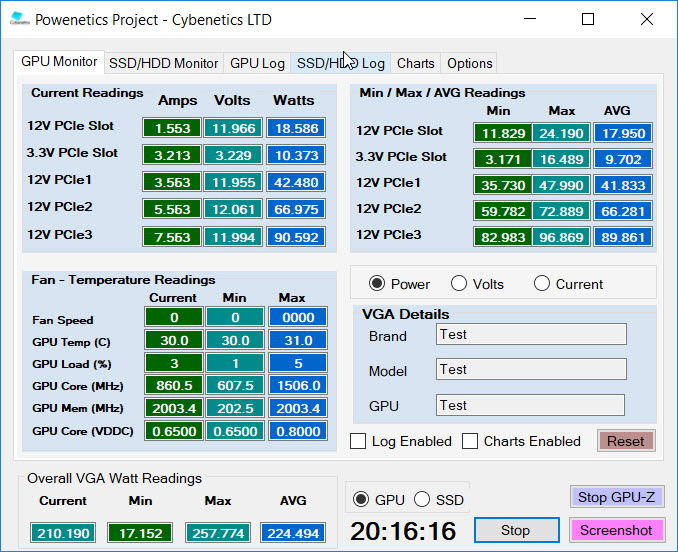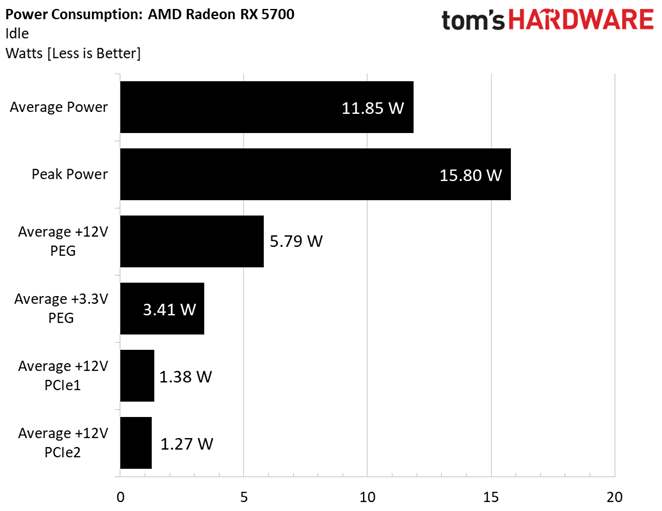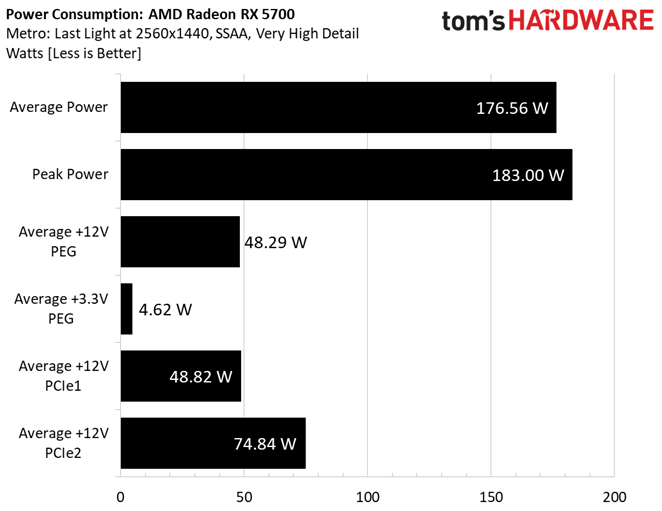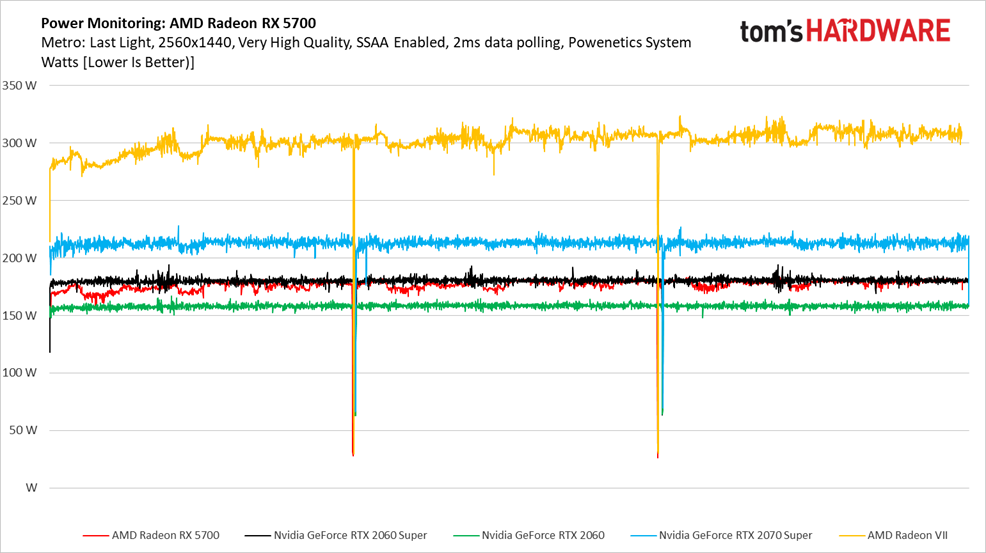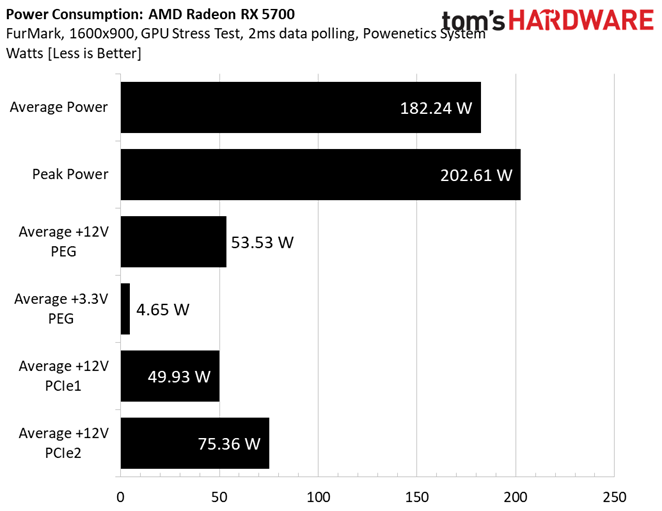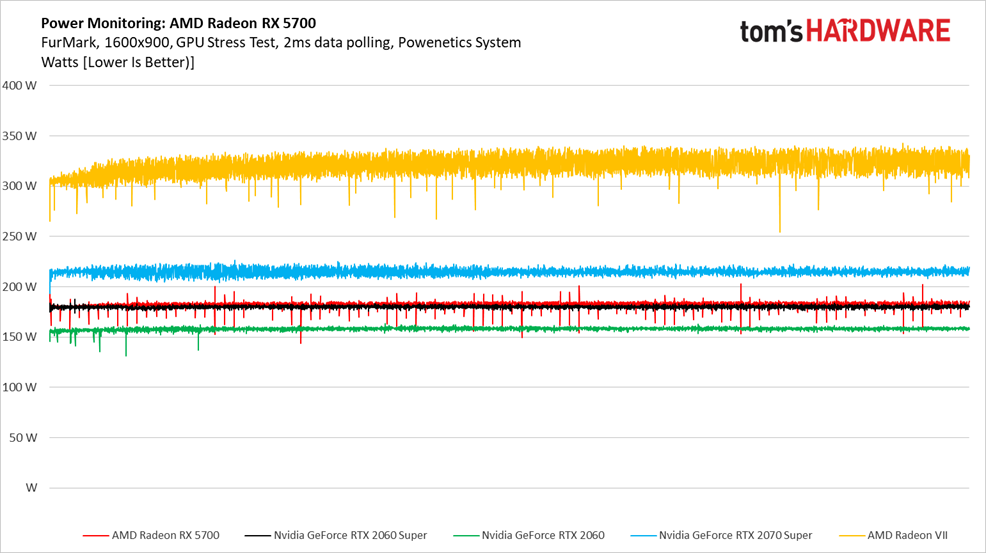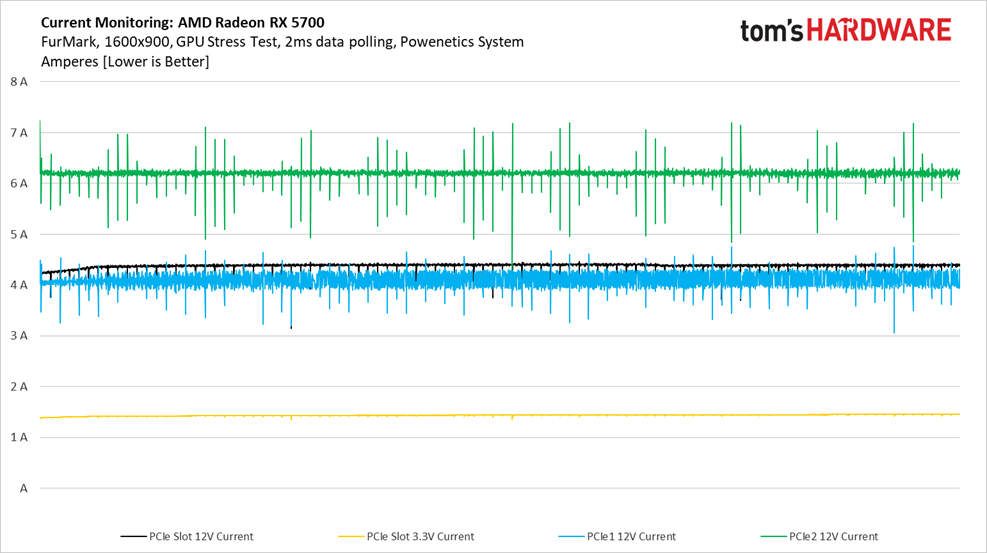AMD Radeon RX 5700 XT and Radeon RX 5700 Review: New Prices Keep Navi In The Game
The Radeon RX 5700 series bests its Nvidia competitors but lacks ray tracing and tensor core hardware.
Why you can trust Tom's Hardware
Power Consumption: Radeon RX 5700
The US Tom’s Hardware graphics lab continues utilizing Cybenetics’ Powenetics hardware/software solution for accurately measuring power consumption.
Powenetics, In Depth
For a closer look at our U.S. lab’s power consumption measurement platform, check out Powenetics: A Better Way To Measure Power Draw for CPUs, GPUs & Storage.
In brief, Powenetics utilizes Tinkerforge Master Bricks, to which Voltage/Current bricklets are attached. The bricklets are installed between the load and power supply, and they monitor consumption through each of the modified PSU’s auxiliary power connectors and through the PCIe slot by way of a PCIe riser. Custom software logs the readings, allowing us to dial in a sampling rate, pull that data into Excel, and very accurately chart everything from average power across a benchmark run to instantaneous spikes.
The software is set up to log the power consumption of graphics cards, storage devices, and CPUs. However, we’re only using the bricklets relevant to graphics card testing. AMD's Radeon RX 5700 and Radeon RX 5700 XT get all of their power from the PCIe slot, one eight-pin auxiliary connector, and one six-pin connector.
Idle
AMD Radeon RX 5700 gets most of its power from the PCIe slot’s +12V rail at idle, followed by the slot’s +3.3V rail. Power over the auxiliary connectors is kept to a minimum.
Gaming
In what might come as a surprise to some, the Radeon RX 5700 averages less power consumption through our Metro benchmark sequence than the company’s 185W board power specification. We’re accustomed to seeing launch numbers that push the boundaries of what companies like AMD and Nvidia tell us to expect. But in this case, even the 5700’s worst-case peak lands shy of the paper ceiling.
Get Tom's Hardware's best news and in-depth reviews, straight to your inbox.
Breaking power consumption up into each rail over time shows that the Radeon RX 5700 gets most of what it needs from the eight-pin auxiliary connector. Meanwhile, the PCIe slot and six-pin connector deliver the same 48W or so.
Radeon RX 5700 is represented by the red line in this chart. By matching or dipping under GeForce RTX 2060 Super, AMD demonstrates just how much Navi improves upon Vega’s performance per watt.
Of course, the GeForce RTX 2060 uses significantly less power, while GeForce RTX 2070 Super uses quite a bit more. But it’s the Radeon VII that stands out most for spending time well above the 300W mark.
Current draw over the PCIe slot’s +12V rail lands well below its 1.1A/pin maximum.
FurMark
Power consumption jumps a bit under FurMark. However, our 182W average is still lower than AMD’s 185W board power specification.
Firing up FurMark reveals dips and spikes over the two auxiliary power connectors that weren’t an issue in Metro. When we drill down into the data, current draw over eight-pin connector is taking >1A dips for one sample and sometimes popping back up in the next 2ms sampling window. The six-pin connector does this to a lesser extent, while the PCIe slot’s +12V rail encounters periodic dips (but no spikes). Cumulatively, we end up with an overall line chart that appears more dramatic. Peak power consumption, however, only gets up to about 202W.
We asked AMD to look at our data and help diagnose the cause of those spikes. Its official response is:
“The behavior you are seeing under a purely synthetic power virus (FurMark) workload is within our specified product parameters.
There are many different sensors and related algorithms that work to keep the GPU working within its prescribed product limits; the behavior depicted and described suggests that specific workload segments in FurMark are periodically causing a rapid ramp in temperature. When the algorithms respond, there is an intentional, designed-in delay which results in the observed ‘spike’.
The absolute values displayed are still within spec, showing that the electrical and thermal protection mechanisms built in to the RX 5700 series are working per design.”
Radeon RX 5700’s power consumption in FurMark is slightly higher than GeForce RTX 2060 Super, though just barely.
Here’s the data we were talking about under the power graph. Current draw over the power connectors is affected in a way not seen from our gaming workload, though the PCIe slot’s +12V rail shows signs of the same behavior.
MORE: Best Graphics Cards
MORE: GPU Benchmarks
MORE: All Graphics Content
Current page: Power Consumption: Radeon RX 5700
Prev Page Performance Results: 3840 x 2160 Next Page Power Consumption: Radeon RX 5700 XT